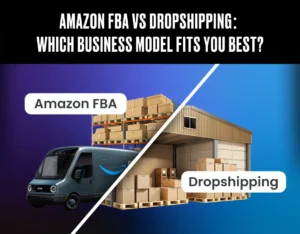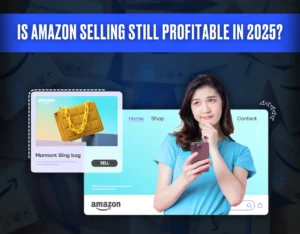As an entrepreneur, do you dream of growing a business without the hassle of packing orders, shipping products, or handling customer service? That dream is exactly what Amazon FBA promises to deliver, but is Amazon FBA worth it in 2025?
Amazon offers the opportunity to manage the logistics via their broad network while you focus on marketing alone. However, FBA can charge a significant 30% off your revenue for bulky products. Understanding this, is it still a profitable chance for new sellers?
In this article, let’s dig into the details of what Amazon FBA offers and see if this is a perfect opening to grow your business or not.
- Amazon remains a strategic asset for reputable brand growth in 2025. Improved policies and support for sellers help to scale businesses substantially.
- As a new seller, you need to pay for the Amazon selling fee, referral fee, FBA fulfillment fee, and storage fee. Fees for different categories can vary based on product type, packaging, and size.
- To stay ahead in the FBA race, focus on products with high demand and low competition. Choose a niche with space for growth and understand the profit potential. Then build a strong brand identity to support your marketing efforts.
Understanding Amazons box size limits is a key step in avoiding unexpected FBA fees and keeping your fulfillment costs under control
Part 1- Is Amazon FBA Worth It in 2025?
If you’re selling on Amazon and want to grow fast, FBA can be highly effective. But it does come with fees and strict compliance policies. Before anything else, let’s explore what FBA is and Amazon’s new policies for 2025.
What is Amazon FBA?
Amazon FBA (Fulfillment by Amazon) is a service for entrepreneurs to manage logistics and customer service. Entrepreneurs store their products in Amazon’s inventory and solely focus on marketing and product sourcing. The company then handles storage, order packing, shipping, and even customer service on their behalf via their vast network. FBA is an excellent catalyst to optimize business growth.
What’s New with Amazon FBA in 2025?
FBA has updated a few key policies for the year 2025 to extend support for all seller categories. The incentives include:
- In 2025, there will be no increase in US referral or FBA fees.
- Additionally, the reimbursement policy for damaged/lost items will not deduct any packing/shipping fees.
- Effective from 15th January, the cost for bulky products has been reduced by $0.58 per unit.
- Amazon has improved ‘New Seller Incentives’ with fee discounts to promote targeted product categories.
Should You Go with Amazon FBA in 2025?
Yes. Amazon FBA is an unrivaled opportunity in 2025, especially for new entrepreneurs and small businesses. Enlisted below are the reasons that you should go with Amazon FBA in 2025:
- Dozens of logistics options
- Enormous customer base
- Storage capacity with very little extra charges
- Trusted fulfillment network
- Secure product handling and customer satisfaction
Part 2- What are the Pros of Amazon FBA in 2025?
Amazon FBA’s trusted services are a strategic advantage for entrepreneurs to build their businesses. Some of the significant benefits include:
- Massive Customer Database: FBA exposes the products to Amazon’s widespread network that draws in more customers.
- Reliable logistics handling: Amazon’s services are trusted and reliable. From managing the inventory to packing, shipping, and dealing with customer queries, everything is streamlined and effortless.
- Higher Product Reach: Brands affiliated with Amazon FBA have better visibility in search results. Products with an Amazon barcode (FNSKU) are kept separate and help it perform better than its competitors.
- Cost-effective: By reducing the costs of storage, packing, and shipping, Amazon FBA is a profitable option for brand growth.
- Increased Scalability: Easily level up your business with fewer employees or warehouse management. With Amazon handling all product logistics, entrepreneurs can focus solely on building a reputable brand.
If you want to ensure your inventory is properly labeled and separated in Amazon’s system, this Amazon FNSKU Barcode guide explains the process clearly.
Cons and Challenges of Amazon FBA
While Amazon FBA’s success rate is high, entrepreneurs can also face a few challenges.
- High FBA fee: FBA charges a referral fee of up to 15% of your revenue, while fulfillment fees vary based on product size and packaging dimensions. For small-scale businesses, these substantial costs can be challenging to absorb and may significantly impact profit margins.
- Products Lost/Damaged: With an extensive inventory of products, your products can be lost/damaged. According to the recent policy, reimbursement will be offered only for the manufacturing cost of the product.
- Storage Fee: Partnering with FBA means increased competition with similar listed products. Products stored in inventory for too long incur significant long-term storage fees.
To manage ad spend effectively, understanding ACoS Amazon is essential for measuring how your campaigns impact profitability.
Part 3- How Much Does It Cost to Launch on Amazon FBA in 2025?
The cost for amazon FBA includes, selling, referral, shipping, storage, and fulfillment fees. Here is a complete breakdown of the costs to start with FBA.
- Selling Fee: To start as a seller on Amazon, register your account and pay a selling fee. This is offered in two plans:
- Individual Plan: $0.99 per unit sold.
This subscription is for occasional sellers who sell less than 40 units a month.
- Professional Plan: $39.99 per month
The plan covers bigger entrepreneurs with larger selling capacity. Professional plan is cost-effective and gives you access to exclusive features like Buy Box, different tools and sales analysis.
- Referral Fee: This is the amount payable for each item sold through Amazon. This typically amounts to 15% or less of the product’s sale price and is paid by all buyers.
Here is an outline of the fee for different product categories. Automotive and Sports products are charged 12%, or $0.30 per unit sold.

- FBA fee: Once working with FBA, sellers pay a specific packing and shipping fee to Amazon. The amount can vary based on the size and packing of the product.
For a 2 oz parcel or less, the fee is $3.25. Likewise, bulkier products up to 50 lbs are charged $10.65.

- FBA Storage Fee: Since FBA involves the use of Amazon’s warehouses, the sellers may incur some fees for using them. You could be paying on a monthly or long-term basis. Usually, these prices depend on the cubic feet space your products occupy. The products are
The following is a quick overview of these prices:
- Monthly Storage Fee: If any of your products remain in Amazon’s inventory at the end of the month, a monthly storage fee will be applied. The fee is usually charged per-day basis, with different rates in different months. For intense, off-peak seasons, like January – September often has lower costs, around $0.78 per cubic foot.
- Long-Term Storage Fee: Warehouses are inspected on the 15th of every month with an LPN number, and inventory is updated accordingly. Any product that has sat on the fulfillment shelves for more than 180 (6 months) days is considered ‘aged’. Current rates are $6.90 per cubic foot or $0.15 per unit over 365 days storage.
Types of Sellers FBA is Best For in 2025
Amazon hosts businesses of all sizes, but the FBA platform is especially well-suited for new and small-scale entrepreneurs. For those in the early stages of growth, FBA allows them to offload logistics and focus entirely on marketing.
By minimizing the need for additional staff and inventory management, it also helps reduce operational costs significantly. Additionally, Amazon’s strict customer care policies will build a good customer network.
If you’re just starting out, this guide on how to sell on Amazon from Alibaba explains how to launch a product using FBA with minimal hassle.
Who Might Struggle with FBA?
For order fulfillment with Amazon, it is crucial to have a significant profit margin to offset FBA charges. However, some entrepreneurs are likely to face challenges in working with FBA due to their products. Amazon is strict with product standardization. Non-compliance with Amazon’s policies can result in the removal of your brand from their platform entirely.
Beyond that, competition among similar listed products is high. However, the success rate with FBA would rise naturally with strong marketing in effect.
Part 4- What are the best strategies for succeeding with Amazon FBA?
Understanding Amazon Fulfillment is the opening move. But success comes with the right strategies.
Success with Amazon FBA is very non-demanding if you know the right tactics. To deconstruct, here are some of the best strategies to boost sales while managing brand development.
How to choose the best products for Amazon FBA
Choosing the right category and product is crucial. Once that’s in place, marketing, collecting reviews, and ensuring customer satisfaction become much easier.
Below is a quick walkthrough on how to select the right product with a higher Amazon FBA success rate:

- Higher Demand: To naturally reduce competition, choose a product category with higher demand and fewer sellers. Look out for products sold and shipped by Amazon. Utilize tools like Jungle Scout and Helium10 to view the statistics for products sold each month. If the demand is higher, this will naturally bring in potential customers.
- Less Competitive Niches: Select a niche where there is little to no competition. Avoid markets dominated by well-established or high-volume sellers. Instead, analyze competitor listings and reviews to spot opportunities.
- Good Profit Potential: Explore products that have a higher profit margin. Source products from cheaper manufacturers to improve the retail arbitrage strategy. Estimate all the costs, FBA fees, and a good profit potential after finalizing the price. Smaller products have lower FBA fees.
- Know Your Buyers: Understand the keywords buyers use to find the product. Carefully fill in the gaps between poorly listed products to improve your ranking in search results.
How can effective marketing and branding be achieved with Amazon FBA?
With competitors crowding the platform, strong marketing is crucial to attracting more customers. Let your product stand out with stronger and polished marketing. Here are a few quick tips:
- Make Your Amazon Presence Noticeable: Allow your brand to stand out with strategic marketing. Focus on what sets you apart to position the product as a better choice.
- Utilize high-quality photos and engaging captions to capture the buyer’s attention.
- For a registered brand, create an Amazon storefront for credibility. Potential buyers can see all your products in one place.
- Utilize Amazon-sponsored ads (PPC) to increase your search visibility and generate more leads.
- Use Amazon TACoS to compare sales and marketing expenses.
- Build a Brand Identity: Color perception is one of the most potent tools for distinguishing between products. By using consistent colors and logos in your branding, you make it easier for customers to remember your product.
- Multi-platform marketing strategy: For the growth of your brand, do not rely solely on Amazon FBA. Draw in customers for your products by marketing on different social media sites.
Conclusion
As a final thought, is Amazon FBA worth it in 2025? Yes! Amazon fulfillment services may seem a bit pricey. However, they offer a smart way to grow your brand steadily. Amazon focuses on buyers more than the sellers and thus is strict with compliance.
To succeed with FBA, focus on offering high-quality products and strong marketing. Meeting the standardization protocol avoids penalties but also helps you achieve better visibility and higher profit margins.
Discover practical tips and strategies for selling successfully on Amazon in our guide on Amazon PPC advertising tips.
Frequently Asked Questions
Is Amazon FBA worth it in 2025?
Yes. Amazon FBA is an invaluable asset, especially for small businesses. It allows sellers to shift their focus entirely to marketing while Amazon handles logistics and fulfillment.
How does Amazon FBA work?
Brands working with FBA store their products in the Amazon inventory. The platform manages logistics and customer service in return for a specific fulfillment fee on every sale.
What is the referral fee for Amazon?
It is a ‘commission’ fee for all products sold through Amazon’s platform. This fee is payable by FBA and FBM users. Referral percentage is different based on product type.
What is the time for long-term storage at FBA?
Any product that exceeds 181 days in the Amazon inventory becomes an ‘aged’ product. A long-term storage surcharge fee is payable for them.
Can I sell or buy an FBA account?
It is completely legal to buy or sell an FBA account. However, sellers need to seek permission from Amazon for a smooth transition.





